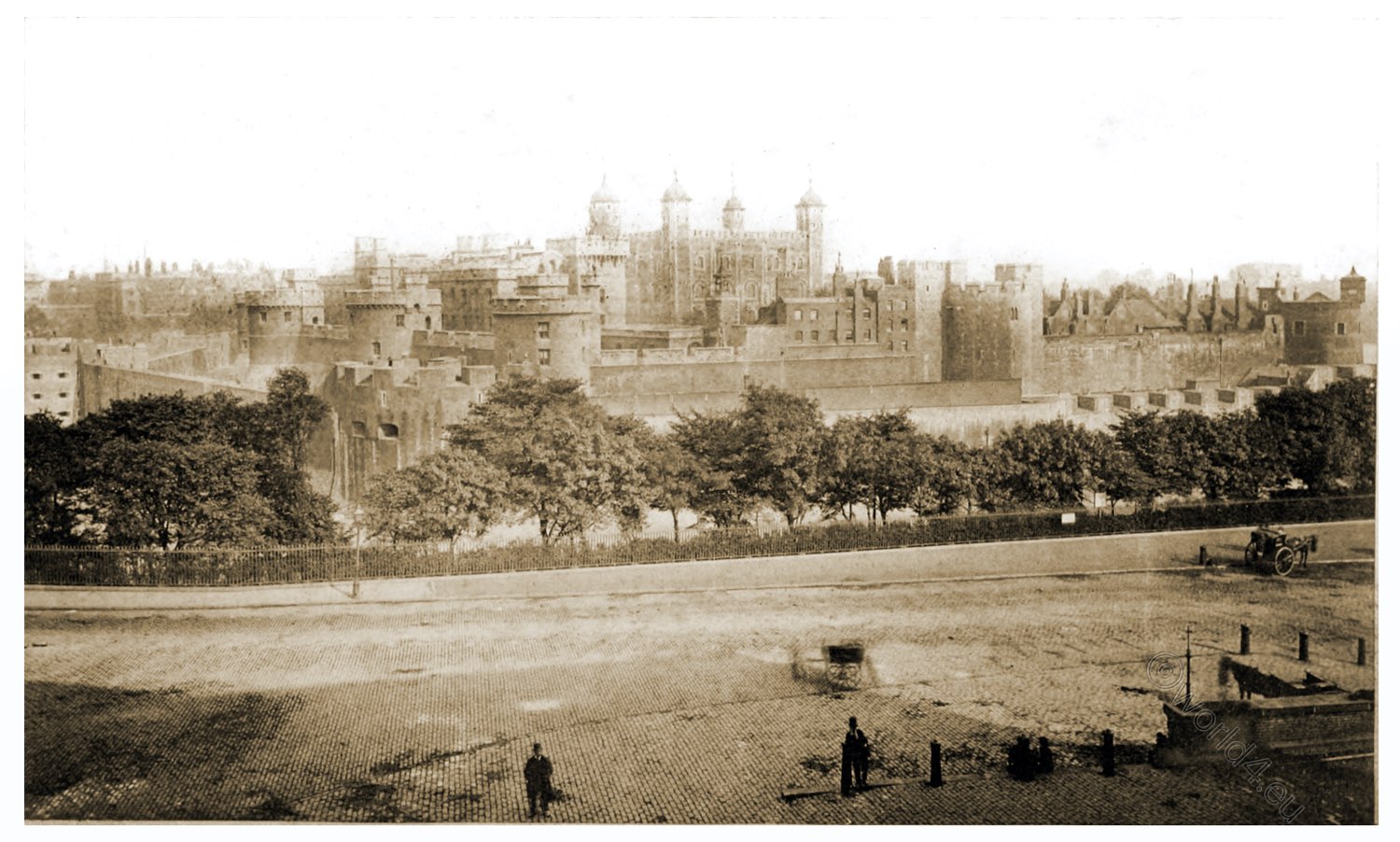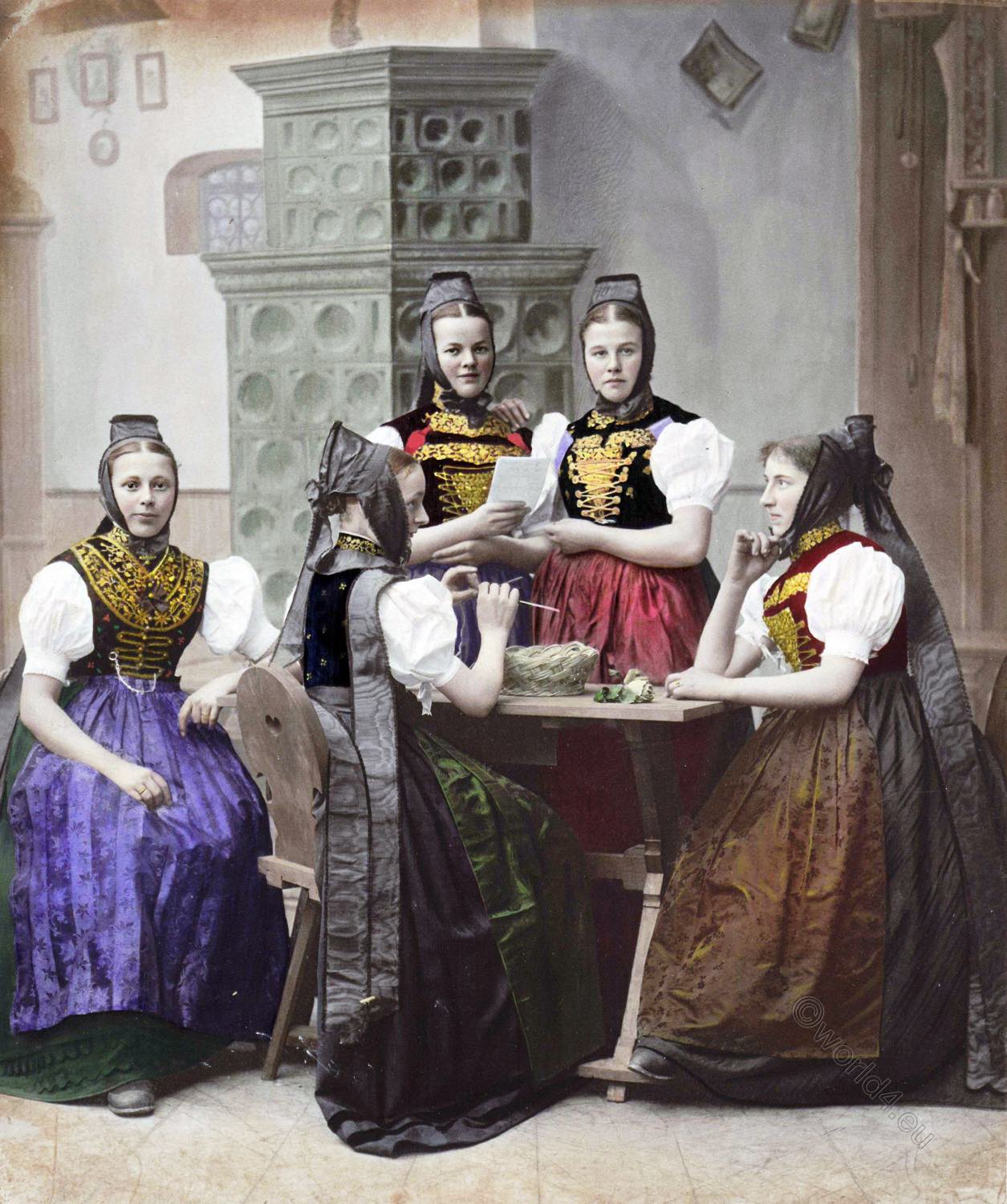THE TOWER OF LONDON
THERE are no myths or legends connected with the building of London’s great fortress, the clear light of history beats upon the erection of its walls. It was built by William the Conquerer, not as a protection for the city, but as a proof of his dominating power over the subdued but possibly troublesome citizens. Part of the Roman wall which encircled the city was removed, and the tower rose into being upon the easternmost corner of Saxon London, right on the shore of the River Thames, the great highway from the sea.
Various additions were made by succeeding monarchs down to Edward III., until it assumed the shape we now see it, with the solid Norman keep in the centre, an inner wall with twelve towers, protected by a strong outer wall surrounded by a deep moat. Only four gateways gave entrance to the fortress, and those were strongly guarded by towers.
Any enemy at tempting to enter from Tower Hill had to force his way across three branches of the moat, with three successive towers before he could reach the inner wall of the citadel. There were three gateways from the river, a small postern gate for the use of State visitors, the main water gate, which earned the ominous title of Traitor’s Gate, due to the frequent arrival of State prisoners, and another entrance east of the Traitor’s Gate.
Owing to its immense strength it was more commonly used by the Kings during times of civil war, when from behind its bastioned walls they could bid defiance to the surging mobs outside. John, Edward II., Henry VI., and Edward IV. all retreated there for safety during their troublous reigns, but it is with Richard II., the boy-King, that we associate one of the most dangerous episodes in the eventful life of the city.
One midsummer day in 1381 a frenzied mob of countrymen swarmed on Tower Hill, demanding, with no uncertain voice, are dress of grievances. Within the Tower there was great hesitation, the councillors of fifteen-year-old Richard vacillating between a sally with force upon the ill-armed peasants and a granting of their just demands.
With something of the insistence of the market-women of Paris when they swarmed up to the gates of Versailles, the savage crowd gained admittance into the Tower, searching for their supposed enemy, the Archbishop of Canterbury, who, as the chief lawyer in England, represented the men who enslaved and starved them. Seizing the poor old man, they dragged him out to Tower Hill, and, with their summary judgment, cut off his head then and there. The story of how Richard saved the situation at Smithfield after the death of Wat Tyler is well known.
Nothing now remains of the palace where the Plantagenet Kings held their Court. It was situated between the White Tower and the Wakefield and Lanthorn Towers. Scarcely used after the reign of Henry VII., save for three days previous to the Coronation procession through the city, it was completely demolished in the reign of William and Mary, every fragment being removed.
The most romantic as well as the most pathetic incidents in the history of the Tower are connected with its forlorn prisoners, doomed to long incarceration or speedy death at the will of despotic monarchs. Even the sovereigns themselves were often captives within its walls.
The two young Princes, Edward V. and his brother Richard, entered the Tower under the nominal protection of their uncle Richard III., never to appear again. Anne Boleyn returned as a prisoner to the place which she had formerly entered in triumph just before her Coronation. Retaining her gay spirit to the end, Anne laughingly remarked that she had a little neck, when told that death by execution was quite painless.
During the reign of her sister Mary, Queen Elizabeth was brought through the Traitor’s Gate to the Tower, where she was confined for some time under suspicion of being implicated in Sir Thomas Wyatt’s rebellion.
Though ceasing to be a royal palace, and of little use as a fortress, the Tower retained its position as a State prison until 1820, becoming since then merely a barracks and a guard-house for the Crown jewels.

The Tower of London was erected by William the Conqueror, 1078, as a stronghold to shelter himself and to awe the rebellious and patriotic citizens of London who spurned the iron rule of him who sought to crush them. The massive grandeur of the structure fitted it well to accomplish these ends.

The Tower and Thames from Horselydown. In the centre is the White Tower and below it St. Thomas’s Tower with its archway known as the Traitor’s Gate, which was the water entrance.
The Thames was the scene of great pomp on the 29th of May, 1533, when Henry VIII. received Anne Boleyn at the Tower. The Lord Mayor and his civic train arrayed in scarlet with large gold chains round their necks, had escorted her in their gay barges from Greenwich, “and she landed midst the great melody of trumpets and divers instruments, and a mighty peal of guns;” next day she proceeded from the Tower, with “all the pomp of heraldry and pride of power,” to Westminster, arrayed in silver tissue, and a mantle of the same lined with ermine, her dark tresses flowing down her shoulders and her head encircled with precious rubies; how different three years after when she was committed to the Tower on the charge of unfaithfulness to Henry, and inhabited the same apartments which she did at the time of her triumph before her coronation.
On the 19th of May a mournful procession passed over the Tower Green: Anne was on her way to the scaffold! Again, in 1553, the Tower was the scene of the ten days’ reign and subsequent martyrdom of the saint-like Lady Jane Grey.

Group of Yeoman Warders, commonly called beefeaters, a corruption of “buffetiers,” sideboard men; they were anciently the servants of the Constable of the Tower, employed by him to guard the prisoners and watch the gates; but through the influence of the good Duke of Somerset, Protector during Edward VI.’s minority, as a reward for their attention to him whilst a prisoner in the Tower, they were appointed extraordinary yeoman of the guard, and they have ever since worn the livery of that body, which was instituted by Henry VII. The honour of the appointment is generally bestowed on veterans who have distinguished themselves in their country’s service.

St. Thomas’s Tower. This is a large square building over the Moat, protected by two circular towers, which exhibit interesting specimens of the early pointed architecture of Henry III.’s reign; underneath this tower is the Traitor’s Gate.

Interior of Horse Armoury. The Armoury is 150 feet in length, and 34 in breadth, and is occupied by figures, some equestrian and some on foot, in suits of armour of various periods from the reign of Henry V., 1422, to that of James II., 1685.

The Crown Jewels were first kept in the Tower in the reign of Henry III., 1216. The collection is surmounted by the crown of H.M. Queen Victoria, which is valued at £1,000,000; Then St. Edward’s Crown, the Prince of Wales’s Crown, the ancient Queen’s Crown, the Queen’s Diadem, St. Edward’s Staff, the Royal Sceptre, the Rod of Equity, the Queen’s Sceptre, the Ivory Sceptre, Queen Mary’s Golden Sceptre, the Sword of Mercy, the Sword of Justice, the Coronation Bracelets and Spurs, the Anointing Vessel and Spoon, the Golden Salt Cellar, a Baptismal Font, and a beautiful Service of Sacramental Plate.

St. Peter’s Church is a plain stone building, consisting of a nave and one side aisle. It is devoid of ornament, but the simple structure contains that which awakens thoughts of deep and solemn interest. Here rests in peace the revered Lady Jane Grey, a Northumberland, and a Norfolk, Thomas Cromwell, the noble Earl of Surrey, the good Duke of Somerset, the brilliant Earl of Essex, the saintly Sir Thomas Moore, and the beautiful Anne Boleyn.

The Byward Tower. This Tower resembles the middle tower, standing at the south-west angle of the fortress, it forms the principal entrance to the exterior line of fortifications. The Gunpowder Plot conspirators were confined in this tower.

Traitor’s Gate. Two strong water-gates connected with the Thames, through which State prisoners entered the Tower. How often have grandeur and even royalty passed beneath its ominous portals to exchange the dreams of honour and glory, and the festive brilliancy of courts, for the realities of the prison lodging, the torture room, or the fatal block and axe. The last State prisoner was Sir Francis Burdett, the father of our esteemed Lady Burdett Coutts.

The Bloody Tower. This is the only rectangular tower belonging to the inner ward; it adjoins the Round Tower. This is the traditionary scene of the murder of the two sons of Edward IV.; the top window is said to be the room in which the Princes were smothered: their remains were removed to Westminster Abbey by King Charles II., 1678.

White Tower. This massive quadrangular structure occupies the central part of the inner ward; it measures 116 feet from north to south, and 96 from east to west, the height is 92 feet; it is embattled, and has watch towers at each angle; it consists of three lofty storeys besides spacious vaults in the basement; the internal walls are 15 feet in thickness. War stores are deposited in every part of the White Tower, Queen Elizabeth’s Armoury excepted.

The Bell Tower and Inner Ballium Wall. It is so called by being surmounted by the alarm bell of the garrison. It was anciently a prison lodging. The venerable Fisher, Bishop of Rochester, was imprisoned here by Henry VIII. It is also asserted that this was Queen Elizabeth’s lodging when a prisoner in the Tower.
Source:
- Peeps at royal palaces of Great Britain by Beatrice Home. London: A. and C. Black 1913.
- York’s photographs of the Tower of London
Continuing
Discover more from World4 Costume Culture History
Subscribe to get the latest posts sent to your email.







